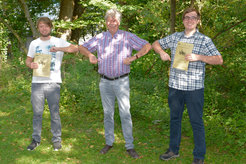Kippenhahn Prize for two supernova papers
The best student publications at MPA in 2019 are two supernova papers: Andeas Flörs is awarded with the Rudolf-Kippenhahn-Prize for his paper entitled “Sub- Chandrasekhar progenitors favoured for Type Ia supernovae: evidence from late-time spectroscopy” and Simon Huber for his paper on “Strongly lensed SNe Ia in the era of LSST: observing cadence for lens discoveries and time-delay measurements”.

The Kippenhahn prize was established in 2009 and is named in honour of Prof. Rudolf Kippenhahn, former director of MPA, to motivate students to write a good publication. Criteria for the prize are that the student is first author and has contributed substantially to the scientific ideas, calculations and analysis, and the writing of the paper. For 2019, the committee decided to award the Kippenhahn prize to two winners for two very different supernova papers.
In his paper, Andreas Flörs uses late-time (’nebular’) spectra of type Ia supernovae to constrain their progenitors. In particular, he uses the differences in the abundances of iron-group elements predicted by the different progenitor channels: only near-Chandrasekhar mass white dwarfs reach the high central densities required to synthesize stable iron and nickel by electron capture reactions. Exploding white dwarfs with lower mass and thus lower central density predominantly produce radioactive 56 Ni instead. A key diagnostic of the central density is the presence of Ni lines in late-time spectra when all radioactive Ni has decayed. Andreas has developed a method by which the fraction of neutron rich (57 Ni and 58 Ni) material synthesized in the explosion can be determined from optical data alone. This allowed him to model archival type Ia supernovae of the past 30 years. His conclusions are striking: He finds that for reasonable progenitor metallicities the fraction of stable Ni is in agreement with the predictions of sub-Chandrasekhar mass models but rules out Chandrasekhar-mass models as the main explosion channel.
Strongly lensed supernovae are emerging as a new probe of cosmology and stellar physics. Even though lensed supernovae are very rare with only 2 events known so far, hundreds of such events are expected in the upcoming Rubin Observatory Legacy Survey of Space and Time, LSST. Different observing strategies of LSST will highly affect the number of lensed supernovae detected. Simon Huber, in his paper, took on the challenge to answer two important questions: (1) what is the optimal LSST observing strategy for lensed supernovae, and (2) how well can the time delays between the multiple images of microlensed supernovae be measured for cosmological studies? The main conclusions from his thorough analysis are that the current LSST observing strategies are insufficient to provide precise time delays for most of the lensed SN Ia systems. Therefore, he is advocating for using LSST as a discovery machine and obtaining follow-up observations for precise time-delay measurements within 5% uncertainty. This paper is one of the A&A highlighted papers across all areas of astronomy and astrophysics published in 2019.
